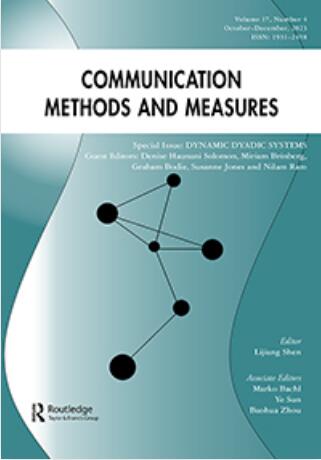Capturing a News Frame – Comparing Machine-Learning Approaches to Frame Analysis with Different Degrees of Supervision
IF 3.7
1区 文学
Q1 COMMUNICATION
引用次数: 1
Abstract
ABSTRACT The empirical identification of frames drawing on automated text analysis has been discussed intensely with regard to the validity of measurements. Adding to an evolving discussion on automated frame identification, we systematically contrast different machine-learning approaches with a manually coded gold standard to shed light on the implications of using one or the other: (1) topic modeling, (2) keyword-assisted topic modeling (keyATM), and (3) supervised machine learning as three popular and/or promising approaches. Manual coding is based on the Policy Frames codebook, providing an established base that allows future research to dovetail our contribution. Analysing a large dataset of 12 Austrian newspapers’ EU coverage over 11 years (2009–2019), we contribute to addressing the methodological challenges that have emerged for social scientists interested in employing automated tools for frame analysis. While results confirm the superiority of supervised machine-learning, the semi-supervised approach (keyATM) seems unfit for frame analysis, whereas the topic model covers the middle ground. Results are extensively discussed regarding their implications for the validity of approaches.捕捉新闻框架——比较机器学习方法与不同监督程度的框架分析
基于自动文本分析的框架图的经验识别已经就测量的有效性进行了深入的讨论。除了对自动帧识别的不断发展的讨论之外,我们还系统地将不同的机器学习方法与手动编码的黄金标准进行了比较,以阐明使用其中一种或另一种的含义:(1)主题建模,(2)关键词辅助主题建模(keyATM),以及(3)监督机器学习作为三种流行和/或有前途的方法。手动编码基于政策框架代码簿,提供了一个既定的基础,使未来的研究能够与我们的贡献相吻合。通过分析12家奥地利报纸在11年(2009-2019年)内对欧盟的报道的大型数据集,我们有助于解决对使用自动化工具进行框架分析感兴趣的社会科学家所面临的方法学挑战。虽然结果证实了监督机器学习的优越性,但半监督方法(keyATM)似乎不适合帧分析,而主题模型则涵盖了中间立场。关于结果对方法有效性的影响进行了广泛讨论。
本文章由计算机程序翻译,如有差异,请以英文原文为准。
求助全文
约1分钟内获得全文
求助全文
来源期刊

Communication Methods and Measures
COMMUNICATION-
CiteScore
21.10
自引率
1.80%
发文量
9
期刊介绍:
Communication Methods and Measures aims to achieve several goals in the field of communication research. Firstly, it aims to bring attention to and showcase developments in both qualitative and quantitative research methodologies to communication scholars. This journal serves as a platform for researchers across the field to discuss and disseminate methodological tools and approaches.
Additionally, Communication Methods and Measures seeks to improve research design and analysis practices by offering suggestions for improvement. It aims to introduce new methods of measurement that are valuable to communication scientists or enhance existing methods. The journal encourages submissions that focus on methods for enhancing research design and theory testing, employing both quantitative and qualitative approaches.
Furthermore, the journal is open to articles devoted to exploring the epistemological aspects relevant to communication research methodologies. It welcomes well-written manuscripts that demonstrate the use of methods and articles that highlight the advantages of lesser-known or newer methods over those traditionally used in communication.
In summary, Communication Methods and Measures strives to advance the field of communication research by showcasing and discussing innovative methodologies, improving research practices, and introducing new measurement methods.
 求助内容:
求助内容: 应助结果提醒方式:
应助结果提醒方式:


